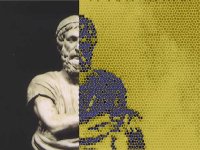Homer Meets High-Tech: Data Visualization and the Classics
One teacher spiced up “The Iliad” with data visualization, inspiring middle school students to take a fresh look at narrative, themes, characterizations, and methods of fact-based inquiry.
How do you make a 3,000-year-old text relevant to young readers? As a middle school literature teacher, it's hard to keep the entire class excited and involved throughout a multi-week unit. It’s even harder when that text is, say, The Iliad. So I recently tried a new tactic.
Inspired by an approach that melded scientific study with literature and some interesting visualization for Homer’s Iliad from LitCharts and moebio, I proposed that we attempt a similar visualization. My class quickly jumped on board. After discussing a few ideas, we decided to track instances of rage in the epic. Rage, after all, is the first word of the 15,693-line text. So, every time one character became angry with another character, we took note -- over a two month period.
From teaching teamwork to incorporating real-world technologies, here are seven reasons why you should try visualization the next time you teach a classic.
1. An Inherently Interdisciplinary Process
If you're not familiar with data visualization, it's the presentation of data in graphical form. First the class made a hypothesis, such as, "The Achaeans yell at each other more than at the Trojans," or "Zeus is the angriest god." Then we designed a spreadsheet to organize our observations, making a note on the sheet each time a relevant incident occurred. Once the reading was complete, we analyzed the spreadsheet's data to test the validity of our original hypotheses. Students then wrote persuasive essays, drawing insights from those analytics and citing the logged data points as evidence.
Analyzing a piece of literature this way turns the work into a piece of robust data that can be understood quantitatively, in addition to allowing a qualitative reading. It invites students to consider literature through a scientific methodology and helps them to understand structures and patterns behind long narrative works.
2. Framing Study to Teach Agency
When students frame the study themselves (i.e. choosing to track the theme of anger), they have inherent buy-in. Plus, the act of choosing a theme is a lesson in itself. We debated other major themes, including sacrifices and prayers, or successes and failures. These conversations made us all think a little harder about what makes a central literary theme and how it may evolve throughout the entire text.
3. Data Management and Design Thinking
Once we decided on a theme, we then had to find a way to manage it. We held a design contest where each student had to design a spreadsheet to best capture the data over a two-month period. The contest had students think about user-friendly design. What information did we need to capture? How could it be organized?
4. Teamwork and Communal Analysis
For the duration of the project, we all shared one Google Spreadsheet where everyone had editing access. The class created a schedule that placed three students in charge of data entry, maintenance, and accuracy each week. This collaboration created its own arena for teachable moments surrounding teamwork and maintaining the integrity of a shared work product.
5. New insights: Friends or Frenemies?
Not only did this project unite the class around a shared activity, but in the process, my students actually shed new light on a 3,000-year-old text.
We learned that leaders like Agamemnon, Zeus, and Hector attract the most rage, and that allies inside the Trojan War prefer to yell at each other rather than at their enemies. With bullying and social relationships so volatile in middle school, it was enlightening for my students to gain insight about interpersonal relationships from an ancient text.
We also needed to debate whether or not Helen should be classified as an Achaean based on her place of birth, or a Trojan based on her current residence. This led to insights and meaningful discussions regarding identity and place. How much of who you are comes from your heritage versus current culture? In case you're wondering, after Book Three we all agreed that she was Achaean at heart.
6. Fact-Based Inquiry
Armed with these new insights, we were able to ask big questions:
- What does it say about a culture that the leaders both rage and are raged at the most?
- What does it say about war when enemies can be friends, and allies can hate each other?
- What were Homer's intentions in addressing rage?
Armed with data, we could push forward interesting thesis statements that would be impossible without the evidence. For example, one student argued that this culture valued strength above other characteristics, like intelligence or spirituality; leaders needed to offer the most threats in order to maintain power.
7. It's Free!
All you need is an internet connection. In addition to Google Sheets (a free spreadsheet tool in Drive), there are free data visualization tools like RAW and Infogr.am that don't require any special training. In fact, my students found these resources on their own. So you can try this out in your classroom without having to purchase supplies or expensive software. For more information, you can also watch my video on the project:
